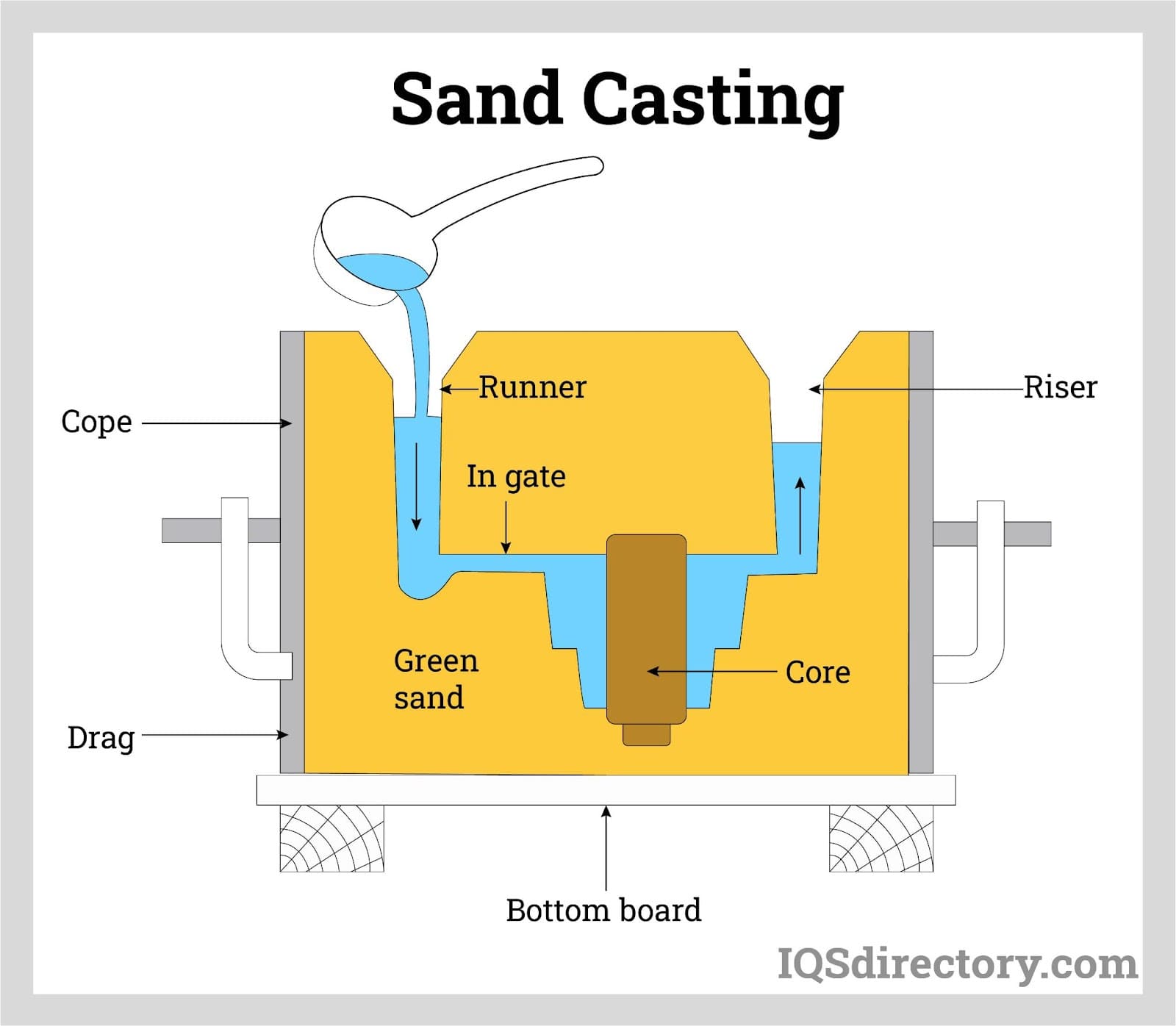The importance of Aluminum Foundry Wisconsin in casting projects
How Aluminum Foundry Contributes to Developments in Aerospace Design
Aluminum shops are essential to advancements in aerospace design. They create lightweight, high-strength elements that are essential for modern-day airplane. Through innovative spreading strategies, these factories produce complicated geometries that boost structural stability. Additionally, the advancement of premium Aluminum alloys sustains the market's concentrate on fuel efficiency and sustainability. Difficulties remain in the production process. Recognizing these elements exposes the profound effect of Aluminum on air travel's future.
The Significance of Lightweight Products in Aerospace Layout
As the aerospace sector continues to advance, the value of lightweight products ends up being significantly evident. The need for performance and sustainability drives designers to prioritize making use of products that decrease general weight without compromising architectural integrity. Lightweight products, especially Aluminum, play an essential duty in enhancing fuel effectiveness, improving payload capacity, and boosting the total efficiency of airplane.
The assimilation of these materials allows for ingenious layouts, enabling producers to develop even more wind resistant shapes that can endure severe conditions. The reduction in weight not only decreases operational prices however likewise adds to a lowered environmental impact, lining up with international initiatives toward sustainability in air travel.
Advanced Casting Techniques in Aluminum Foundries
Advanced spreading methods in Aluminum shops play a crucial role in aerospace engineering by enabling the production of lightweight and accurate parts. Innovations in mold and mildew style and precision casting processes are vital in achieving perfect performance and architectural stability. Furthermore, the development of light-weight alloys improves the overall efficiency and effectiveness of aerospace applications.
Cutting-edge Mold Style
Cutting-edge mold style plays a necessary duty in the effectiveness and efficiency of Aluminum foundries, specifically within the aerospace industry. By leveraging sophisticated materials and strategies, modern molds can be engineered to stand up to heats and stress, making certain peak performance throughout the casting procedure. These designs commonly incorporate intricate geometries that enable for the manufacturing of lightweight yet structurally audio elements, important for aerospace applications. In addition, using computer-aided layout (CAD) software application assists in precise modeling, making it possible for factories to refine and imitate mold and mildew layouts prior to physical manufacturing begins. This not only improves the high quality of actors parts however additionally decreases waste and lead times, causing significant cost savings. Generally, innovative mold and mildew layout is a cornerstone of progression in Aluminum Foundry modern technology for aerospace design.
Precision Casting Procedures
The efficiency of cutting-edge mold and mildew layouts perfectly integrates with accuracy casting procedures, which are essential for generating premium Aluminum parts in aerospace design. These procedures, consisting of sand spreading, die casting, and investment casting, ensure the production of intricate geometries with limited resistances. Advanced strategies like vacuum casting and stress die casting enhance the integrity and surface area coating of the last items. Precision casting lessens material waste while maximizing the mechanical residential or commercial properties of Aluminum, vital for aerospace applications. On top of that, utilizing real-time tracking and progressed simulation devices during the casting process permits instant modifications, causing improved quality control. Collectively, these accuracy casting processes setting Aluminum foundries at the forefront of aerospace development, supporting the industry's demand for integrity and performance.
Lightweight Alloy Growth
As aerospace designers look for to boost gas effectiveness and efficiency, light-weight alloy growth becomes an essential focus in Aluminum foundries. These foundries utilize sophisticated casting strategies to produce alloys that provide premium strength-to-weight proportions. Advancements in alloy structure, including the unification of elements like lithium and magnesium, enable the manufacturing of products that withstand severe conditions while minimizing overall airplane weight. Methods such as die spreading and financial investment casting promote the precision production of complex forms, which are critical for aerospace applications. In addition, ongoing research intends to optimize these alloys for enhanced mechanical residential or commercial properties and boosted toughness. By prioritizing light-weight alloy advancement, Aluminum shops considerably add to the development of aerospace design, leading the way for extra sustainable and reliable airplane designs.

Enhancing Architectural Stability Through Aluminum Parts
Aluminum components offer considerable advantages in boosting architectural honesty within aerospace engineering. Their lightweight nature adds to total efficiency while maintaining stamina, which is necessary for aircraft performance. Additionally, the anxiety resistance properties of Aluminum help ensure the sturdiness and integrity of aerospace frameworks under different operational conditions.
Lightweight Product Advantages
While conventional materials frequently jeopardize weight for toughness, utilizing Aluminum components in aerospace design offers significant benefits in structural honesty. Aluminum's light-weight nature adds to overall layout efficiency, permitting even more structured airplane that eat less fuel, consequently improving sustainability. The product's exceptional strength-to-weight ratio warranties that components maintain resilience without including unnecessary mass. This high quality promotes improved efficiency and dexterity in trip, along with optimized haul capabilities. In addition, Aluminum's resistance to deterioration prolongs the life expectancy of aerospace structures, minimizing maintenance costs and boosting safety. As manufacturers significantly embrace Aluminum alloys, the aerospace market experiences a transformative change towards a lot more efficient and reliable engineering remedies that focus on both efficiency and environmental obligation.
Anxiety Resistance Residences
Although various materials have distinct residential or commercial properties, Aluminum's remarkable anxiety resistance stands apart as a imp source vital consider enhancing the structural integrity of aerospace parts. This resistance plays an important role in making certain that aircraft can hold up against different operational anxieties, including exhaustion, effect, and environmental problems. Aluminum alloys, especially engineered for aerospace applications, exhibit high tensile strength while keeping light-weight attributes, enabling engineers to design more effective frameworks - Aluminum Foundry. Furthermore, the ability of Aluminum to withstand cyclic loading without substantial contortion adds to the long life and integrity of aerospace parts. As advancements continue in Aluminum Foundry methods, the advancement of stress-resistant Aluminum components promises more renovations in efficiency, safety, and effectiveness across the aerospace sector, strengthening Aluminum's article duty as a favored product in modern-day engineering
Gas Efficiency Improvements Driven by Aluminum Innovations
As the aerospace market looks for to enhance gas performance, innovative uses Aluminum have actually emerged as an essential solution. Aluminum's lightweight nature especially lowers airplane weight, permitting for lower fuel usage throughout flight. This decrease in weight is vital, as even little reductions can bring about substantial renovations in overall gas economic situation.
Advanced Aluminum alloys, created for boosted toughness and durability, make it possible for producers to produce components that keep structural stability while reducing mass - Aluminum Foundry. Additionally, the combination of Aluminum in airframes and engine elements facilitates improved aerodynamics, adding to minimized drag and increased performance
The adoption of Aluminum in aerospace not only satisfies the demand for fuel-efficient style but also aligns with regulative stress for reduced discharges. As these technologies remain to develop, they play a considerable function in establishing new benchmarks for fuel efficiency, guaranteeing that the aerospace industry can fulfill expanding economic and ecological obstacles.

The Role of Aluminum in Sustainable Air Travel Practices
The increasing emphasis on sustainable aviation methods has placed Aluminum as an important product in the mission for greener airplane style. Understood for its light-weight homes, Aluminum significantly lowers aircraft weight, causing lower fuel intake and exhausts. Its recyclability further enhances its sustainability profile, as Aluminum can be reused forever without loss of top quality. This particular supports a circular economic situation within the aeronautics market, minimizing waste and resource exhaustion.
Developments in Aluminum alloys have actually enhanced their strength and deterioration resistance, enabling for longer service life and reduced upkeep requirements. These innovations facilitate the development of extra effective aircraft structures, adding to total sustainability initiatives. Furthermore, Aluminum's thermal conductivity plays a critical role in energy-efficient designs, improving systems such as heat exchangers. Jointly, these qualities underscore Aluminum's essential role in progressing sustainable aeronautics, straightening with international efforts focused on minimizing the environmental influence of flight.
Difficulties Faced by Aluminum Foundries in Aerospace Production
While Aluminum foundries play an important duty in aerospace production, they face significant difficulties that can influence production performance and top quality. One major obstacle is the strict high quality control standards called for in the aerospace industry. Any type of flaw can jeopardize safety and security and efficiency, necessitating rigorous evaluation procedures that extend production timelines. In addition, factories often emulate varying resources expenses, which can impact pricing and productivity. The complexity of Aluminum alloys made use of in aerospace applications more makes complex the manufacturing procedure, as exact solutions are important for accomplishing preferred mechanical properties. Furthermore, competent labor shortages hinder the capacity to keep high-grade my review here manufacturing degrees. Environmental regulations impose restrictions on exhausts and waste monitoring, requiring shops to invest in sustainable methods, which can be cost-prohibitive. These elements collectively develop a landscape where Aluminum factories need to continually adjust to meet the developing demands of aerospace production while making certain safety and security and compliance.
Future Fads in Aluminum Applications for Aerospace Design
With advancements in modern technology and increasing needs for performance, the future of Aluminum applications in aerospace engineering is positioned for considerable improvement. The assimilation of innovative Aluminum alloys and compounds is expected to boost strength-to-weight proportions, leading to even more fuel-efficient aircraft designs. On top of that, improvements in additive manufacturing methods will allow for the production of intricate Aluminum structures that were formerly impossible, optimizing efficiency and minimizing waste.

Lasting techniques will play an essential function, with an expanding emphasis on reusing Aluminum to decrease environmental effect. The aerospace sector is most likely to embrace smarter making procedures, such as automation and expert system, making certain higher high quality and precision in Aluminum elements. Moreover, partnerships in between Aluminum foundries and aerospace firms will cultivate research and advancement, paving the method for new applications that satisfy the strict needs of modern-day aerospace design - Aluminum Foundry. Generally, the future looks guaranteeing for Aluminum's function in forming the skies
Often Asked Concerns
What Are the Environmental Influences of Aluminum Manufacturing in Aerospace?
The ecological influences of Aluminum production in aerospace include significant power usage, greenhouse gas discharges, and habitat disturbance. Additionally, mining processes can lead to soil deterioration and water contamination, increasing worries about sustainability and environmental equilibrium.
Just How Does Aluminum Contrast to Various Other Materials in Aerospace Applications?
Aluminum supplies an one-of-a-kind combination of light-weight buildings, deterioration resistance, and cost-effectiveness contrasted to various other products. Its high strength-to-weight proportion makes it especially helpful for aerospace applications, improving fuel effectiveness and general efficiency in aircraft layout.
What Certifications Do Aluminum Foundry Employees Demand for Aerospace Projects?
Aluminum Foundry workers call for specific training in metallurgy and casting methods, along with knowledge of aerospace market criteria. Certifications in quality assurance and safety protocols are likewise necessary to guarantee conformity with stringent aerospace job demands.
Are There Any Kind Of Safety And Security Interest In Making Use Of Aluminum in Aerospace Design?
Security concerns concerning Aluminum in aerospace engineering consist of susceptibility to tiredness, deterioration, and anxiety cracks. Appropriate treatment and alloy choice are important to mitigate these dangers, guaranteeing structural integrity and total security in aerospace applications.
Just How Does Aluminum Recycling Benefit the Aerospace Sector?
Aluminum recycling greatly profits the aerospace sector by decreasing product prices, decreasing ecological influence, and conserving energy. This lasting technique boosts the market's performance while advertising using lightweight, high-performance parts in airplane production.
Advanced casting strategies in Aluminum shops play a critical role in aerospace design by allowing the manufacturing of exact and lightweight parts. Innovative mold layout plays a crucial role in the effectiveness and performance of Aluminum shops, particularly within the aerospace industry. As aerospace engineers seek to boost fuel performance and performance, light-weight alloy development becomes an essential focus in Aluminum factories. Aluminum alloys, specifically crafted for aerospace applications, show high tensile toughness while maintaining light-weight attributes, making it possible for engineers to develop much more efficient frameworks. Cooperations between Aluminum shops and aerospace companies will certainly promote research and advancement, paving the way for brand-new applications that fulfill the rigorous needs of contemporary aerospace design.